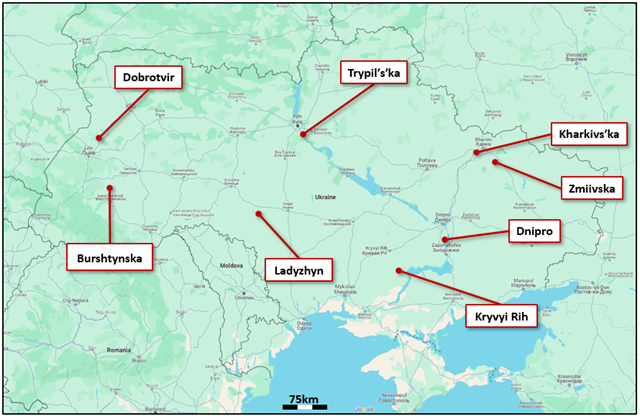Ukraine’s Campaign Targeting Russian Oil Refinery Facilities
Long-range drone and missile strikes on civilian targets and infrastructure rapidly became a defining feature of the Kremlin’s war efforts following its invasion of Ukraine on 24 February 2022. Despite the tempo and intensity of these attacks ebbing and flowing over the course of the past two- and a-bit years, Russia has maintained this campaign throughout. Out of fear of escalating the current hostilities, Western governments have been largely hesitant to provide Kyiv with long-range weapons capable of striking Russian territory proper, despite the Zelensky administration desperately seeking a way to respond to these frequent strikes.
However, the turn of the year saw Ukraine launch a major, concerted campaign to strike energy-related targets inside Russian territory, predominantly using domestically produced drones. Oil refineries have been the primary focus of these attacks and data from 14 April indicates that Ukraine has struck at least 18 oil refineries, carrying a combined capacity of 3.9 million barrels per day (bpd)1 . For context, Russia was predicted to produce 10.54 million bpd this year2 and due to this recent drone campaign, roughly 670,000 bpd of Russian refining capacity was unavailable by the end of March3.

Despite the extensive sanctions put in place on its hydrocarbon sector by much of the international community following the outbreak of the Russia-Ukraine war, Russia remains one of the world’s leading energy exporters4. The targeting of oil refineries appears to have had a visible impact on the global oil markets, with the price of Brent crude spiking nearly 13 percent this year5. Although some have argued that the recent increases predominantly stem from OPEC Plus production cuts and ongoing instability in the Middle East6, rather than the recent disruption of Russian oil refining capabilities. It is likely the cause lies somewhere in the middle, yet it is apparent that conflicts continue to have noticeable impacts on the global energy markets at precarious time economically.
Irrespective of the cause the recent spikes in oil prices, there are anxieties amongst some in the West, particularly in Washington, over the potential effects of a long-term, concerted campaign against Russia’s hydrocarbon infrastructure. Indeed, meetings between top US officials and the political leadership in Kyiv have reportedly seen the former request that Ukraine alter the aims of its campaign and focus on targets with a higher military value7 or risk jeopardising European support by rising energy prices and levels of inflation8. Accusations have however been levelled toward the US that the Biden administration fears rising gas prices will hinder his re-election bid, as for their part, Europe have remained largely supportive of Kyiv’s right to strike9.
The primary aim of Ukraine’s drone campaign is undoubtedly to disrupt Russia’s oil production capabilities, yet the psychological dimension to these strikes should not be ignored. These long-range drone attacks serve to demonstrate to the Russian civilian population, a vast majority of whom are well removed from the frontline across the border, that the conflict will not remain confined to its current geographical space.
It is likely the degradation of Russia’s vital oil infrastructure, which has imposed financial costs on the Putin regime, coupled with the symbolic significance of high-value targets being struck deep inside Russia, which serve to shatter the illusion that Russia’s ‘special military operation’ will remain solely in Ukraine, which has led to a devastating two months of Russian aerial assaults on Ukraine.
Russia’s Overwhelming Response
Following a winter period which saw fewer Russian drone and missile strikes than many had anticipated, March and April have seen the Kremlin pummel Ukraine with aerial attacks on a near-daily basis. Not only has this recent campaign seen strikes notably increase in their tempo and intensity, they have also indicated a change in tactics. Moscow has begun using precision missiles to destroy power stations with less air defence coverage10, at a time in which Ukraine is already struggling with protecting other key sites due a lack of ammunition for their dedicated anti-air weaponry11.
The confluence of these factors has inflicted a devastating impact on the Ukrainian energy grid, with Russia so far having caused more destruction than was seen during the winter of 2022-23, some of which will be long-lasting and irreversible. Indeed, DTEK, Ukraine’s largest energy supplier, reported that it lost around 80 percent of its power generation in the last week of March alone. Consequently, Ukrenergo, the operator of the national grid, has warned the system may need a total overhaul12.
A seven-day period between 22-29 March was indicative of the scale of the Russian air attacks, with Moscow striking at least nine power stations some of which were almost entirely destroyed13. Soon after, the largest power plant in the Kyiv region, was also destroyed, with large gas storage sites in western Ukraine being damaged in the same attack14– further compounding the widespread issues the country is facing with power supplies15.

These attacks have also had a major impact on Ukraine’s civilian population. The UN recorded a marked increase in the number of civilian casualties in March – with the figure rising 20% on the month prior. Indeed, 604 civilians were killed or wounded in March, 57 of which were children16. Many more have been impacted by the planned power outages that have been introduced to prevent the surviving energy infrastructure from being overloaded17.
Outlook
Ukrainian drone attacks on Russian oil infrastructure have largely subsided recently, although the exact reason for this remains unclear. However, it appears as though the ongoing battle between Kyiv and Moscow to degrade each other’s energy facilities will remain a core tenet of the current phase of this conflict. Ukraine is currently facing significant difficulties, largely due to a shortage of weapons and ammunition which have dwindled drastically in recent months – an issue predominantly caused by Republican opposition in the US, who have repeatedly blocked aid packages to Ukraine over the past six months18.
A bill was finally passed by the US Senate on 24 April, meaning Ukraine should soon receive some of the assistance it requires to continue its fight against Russia. However, Ukraine’s frontline and civilian losses continue to mount and future aid from the US is by no means guaranteed, implying that it is well within the realms of possibility that Kyiv decides to launch an increased rate of attacks on Russian oil refineries once again.
While it remains to be seen if Ukraine possess’ both the capability and intent to ramp up drone attacks on Russia in the future, Russian strikes have shown few signs of abating and Putin will want to continue applying pressure on Ukraine at a time in which their position appears increasingly tenuous. Much has been made regarding the potential impact of Ukraine’s drone attacks on global oil prices, yet Russia’s campaign may come to have an equally negative affect on global energy prices. Indeed, the recent targeting of Ukraine’s gas storage facilities, which were being used European gas traders, in the west of the country caused a notable spike in gas prices on the continent19.
This latest campaigns further underscore that there are few dimensions to the Russia-Ukraine that occur in a vacuum. There is a strong potential for both sides to continue, or even increase, the intensity of their strikes. Such a scenario could further impact the global economy via rising energy prices, a prospect few countries would welcome due to the economic difficulties that are currently being felt across much of the world.
The human cost of this latest development in the conflict should not be forgotten, with each strike often impacting local civilian populations. Similarly, the incidental risks posed by the launching of unmanned drones and missiles across vast distances should not be ignored, with there being a potential for civilian aircraft to be misidentified and targeted by these weapons and / or anti-aircraft systems which will remain on high alert for the foreseeable future in both Russia and Ukraine.

Author
Charlie Werb – Security Risk Analyst, Alert:24
Charlie is a Security Risk Analyst within SCR’S in-house security consultancy organisation, Alert:24. This role sees Charlie provide intelligence and expert analysis on a range of security issues to commercial audiences across a wide range of industries, and also serves as a responder to client incidents. Charlie is well-versed on the overall global landscape, but carries a particular expertise on terrorism and African security issues.
Prior to joining Alert:24, Charlie spent time living and working in South Korea, before going on to achieve a Merit in his Master of Arts in International Security and Terrorism at Nottingham University, where he undertook modules in Contemporary Warfare, Covert Action, and the Politics of Terror.
- https://www.cnbc.com/2024/04/14/ukraines-ai-drone-attacks-on-oil-refineries-threaten-energy-markets.html ↩︎
- https://www.reuters.com/business/energy/russian-oil-output-expected-hold-steady-2024-2023-12-27/ ↩︎
- https://www.cnbc.com/2024/04/14/ukraines-ai-drone-attacks-on-oil-refineries-threaten-energy-markets.html ↩︎
- https://www.ft.com/content/98f15b60-bc4d-4d3c-9e57-cbdde122ac0c ↩︎
- https://edition.cnn.com/2024/04/01/energy/ukrainian-drones-disrupting-russian-energy-industry-intl-cmd/index.html#:~:text=Ukrainian%20strikes%20on%20refineries%20have,in%20an%20important%20election%20year. ↩︎
- https://www.washingtonpost.com/national-security/2024/04/15/ukraine-russia-oil-refinery-attacks/ ↩︎
- Ibid. ↩︎
- Ibid ↩︎
- https://www.semafor.com/article/04/16/2024/europe-us-divided-over-support-for-ukraines-strikes-on-russian-oil ↩︎
- https://www.ft.com/content/18882abd-6277-4aae-bc43-f3e5fa786445 ↩︎
- https://edition.cnn.com/2024/04/16/europe/ukraine-missiles-air-defense-zelensky-israel-intl/index.html ↩︎
- https://www.aljazeera.com/news/2024/4/16/ukraine-says-it-ran-out-of-missiles-to-stop-russian-strike-on-power-plant ↩︎
- https://www.ft.com/content/18882abd-6277-4aae-bc43-f3e5fa786445 ↩︎
- https://www.theguardian.com/world/2024/apr/14/an-energy-war-is-being-waged-former-oil-boss-warns-of-price-rises-after-ukraine-infrastructure-attacks ↩︎
- https://www.aljazeera.com/news/2024/4/16/ukraine-says-it-ran-out-of-missiles-to-stop-russian-strike-on-power-plant ↩︎
- https://www.reuters.com/world/europe/un-records-sharp-rise-civilian-deaths-injuries-ukraine-march-2024-04-09/ ↩︎
- https://www.amnesty.org/en/latest/news/2024/04/russian-attacks-causing-catastrophic-damage-to-critical-energy-infrastructure-in-ukraine/ ↩︎
- https://www.bbc.co.uk/news/world-us-canada-68840405 ↩︎
- https://www.theguardian.com/world/2024/apr/14/an-energy-war-is-being-waged-former-oil-boss-warns-of-price-rises-after-ukraine-infrastructure-attacks ↩︎